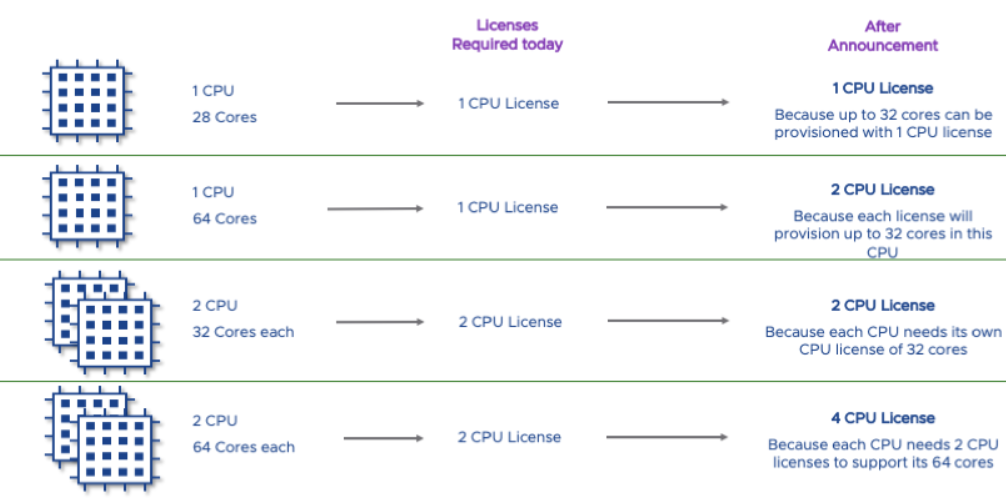Extreme Price Increase For VMware: AT&T Highlights Broadcom's 1,050% Jump

Table of Contents
AT&T's Experience: A Case Study of VMware Price Hikes
AT&T's situation serves as a stark case study illustrating the devastating impact of the VMware price increase. The sheer magnitude of the price hikes imposed by Broadcom is staggering, leaving many questioning the future of VMware pricing and the virtualization landscape.
The Magnitude of the Increase
AT&T reported a shocking 1050% increase in the cost of its VMware software licenses. This isn't a minor adjustment; it's a transformative shift that dramatically alters the cost structure for businesses reliant on VMware solutions.
- vSphere: A reported increase from approximately $10,000 annually to over $110,000.
- vSAN: Experienced a similar surge, with reported increases exceeding 1000% for certain configurations.
- vRealize Operations: Saw a significant price jump, making comprehensive management solutions significantly more expensive.
These figures are not hypothetical; they reflect the real-world financial burdens now facing major corporations like AT&T. The pre-acquisition cost of AT&T's VMware infrastructure was substantial, but the post-acquisition costs are crippling. Before the acquisition, AT&T’s VMware deployment constituted a significant portion of their IT budget; now, it’s an even larger, more burdensome expense.
AT&T's Response and Potential Alternatives
Faced with this unprecedented cost increase, AT&T is likely exploring various alternatives. The sheer magnitude of the price hike necessitates a thorough review of their virtualization strategy.
- Open-source solutions: Migrating to open-source alternatives like Proxmox VE or OpenStack could offer significant cost savings.
- Alternative virtualization platforms: Exploring platforms like Microsoft Hyper-V or Citrix XenServer could provide viable alternatives, although migration complexities must be considered.
- Negotiation with Broadcom: AT&T, and other large organizations, may be attempting to negotiate better pricing terms with Broadcom.
Switching vendors is not a trivial undertaking. Compatibility issues, data migration complexities, and the potential for service disruptions are significant concerns. However, the sheer scale of the VMware price increase makes a thorough evaluation of alternatives a necessity.
Broadcom's Justification for the VMware Price Increase
Broadcom's justification for the dramatic VMware price increase has been met with skepticism across the industry.
Official Statements and Explanations
Broadcom's official statements generally cite increased research and development costs, enhanced product features, and increased market demand as reasons for the price hikes.
- Increased R&D: Broadcom argues that significant investments are needed to maintain VMware's innovation and market leadership.
- Enhanced features: The company claims that new features and capabilities justify the higher prices.
- Market demand: Broadcom points to the continued high demand for VMware solutions as a rationale for price increases.
However, many observers question whether these justifications adequately explain the magnitude of the price increases, particularly the 1050% jump experienced by AT&T. The sheer scale of the increases suggests a potential for significant profit maximization post-acquisition.
Market Impact and Investor Reactions
The VMware price increase has created considerable market ripples. Investor reactions have been mixed.
- Broadcom Stock: While Broadcom's stock initially saw a positive reaction, long-term effects remain to be seen, particularly as businesses explore alternatives.
- VMware Stock: Post-acquisition, VMware's independent stock performance is no longer a relevant indicator.
Financial analysts are divided, with some praising Broadcom's strategic move and others expressing concern about the potential for reduced market share due to customer attrition.
Implications for Businesses and the Future of VMware Pricing
The VMware price increase has profound implications for businesses of all sizes.
Budgetary Constraints and Long-Term Costs
Smaller companies, in particular, face immense pressure to absorb these drastically increased costs.
- Budget cuts: Many companies may have to cut budgets in other areas to offset the increased VMware expenses.
- Project delays: New projects relying on VMware solutions might be delayed or cancelled entirely.
- Reduced innovation: Businesses may curtail investments in other areas of IT to cover rising VMware costs.
The long-term financial impact on businesses will depend on their ability to absorb these costs or successfully transition to alternative solutions.
The Future of VMware: Predicting Potential Price Trends and the Competitive Landscape
The future of VMware pricing and its position in the competitive landscape is uncertain.
- Increased competition: The price hikes are likely to accelerate the adoption of open-source solutions and alternative virtualization platforms.
- Price adjustments: Broadcom may be forced to adjust its pricing strategy based on market response and competitive pressures.
- Market consolidation: The long-term effects of this price shock could lead to further consolidation within the virtualization market.
The VMware price increase is a watershed moment, potentially reshaping the competitive dynamics of the enterprise virtualization sector.
Conclusion: Navigating the VMware Price Increase: What's Next?
The VMware price increase, as exemplified by AT&T's experience with a staggering 1050% surge, presents a significant challenge to businesses worldwide. The magnitude of these hikes necessitates a thorough reevaluation of VMware's place in IT strategies. Managing VMware costs effectively requires careful consideration of alternatives, budgeting, and long-term planning. Explore open-source options, consider alternative virtualization platforms, and actively negotiate with Broadcom—all in a bid to mitigate the impact of this dramatic price shift. Further research into managing VMware costs, exploring VMware pricing strategies, and investigating VMware alternatives is crucial for maintaining a competitive edge in today's rapidly evolving IT landscape. This significant price shift in the enterprise software market will continue to unfold, with its long-term effects shaping the future of virtualization for years to come.

Featured Posts
-
 Amazon Boss Jeff Bezos James Bond Poll The Unexpected Winner
May 12, 2025
Amazon Boss Jeff Bezos James Bond Poll The Unexpected Winner
May 12, 2025 -
 Eric Antoine Apres Son Divorce Il Officialise Sa Relation Avec Sa Nouvelle Compagne Visage De M6
May 12, 2025
Eric Antoine Apres Son Divorce Il Officialise Sa Relation Avec Sa Nouvelle Compagne Visage De M6
May 12, 2025 -
 Reaccion De Boris Johnson Tras Ataque De Avestruz En Texas Detalles Del Incidente Familiar
May 12, 2025
Reaccion De Boris Johnson Tras Ataque De Avestruz En Texas Detalles Del Incidente Familiar
May 12, 2025 -
 Rory Mc Ilroys Daughters Golfing Debut At Augusta
May 12, 2025
Rory Mc Ilroys Daughters Golfing Debut At Augusta
May 12, 2025 -
 Mueller Annonce Son Depart Du Bayern Munich Apres Un Quart De Siecle
May 12, 2025
Mueller Annonce Son Depart Du Bayern Munich Apres Un Quart De Siecle
May 12, 2025
